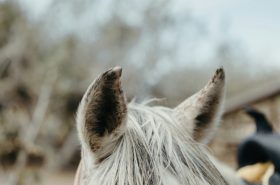Arizona in July is brutal. The days are sweltering and long with little to no breeze. Shade and water are our best friends during this month and there’s no difference between us and our equine friends. Just like us, they can also get hurt from too much sun and not enough water.
There are two important ideas when it comes to sun damage and it’s excruciatingly beneficial to know the difference: sunburn and photosensitization.
Sunburn is skin damage caused by UV radiations to non-pigmented pink-skinned areas of the body, eyes, nose, and muzzle.
Photosensitization is a condition is where the skin becomes overly sensitive to UV light and magnifies the burning effect of the sun, so even a little exposure can cause blistering and peeling. It can be caused by liver damage, drug reaction, or just a genetic predisposition.
What are the signs of sun damage you should look out for?
- Redness/bright pink skin
- Dry, cracked areas (especially around the nose and muzzle)
- Inflammation
- Blisters (possibly even weeping ones)
- Depending on the location of the discomfort they can display head-shyness or difficulty saddling.
As a mama to two paint mares with blue eyes, I know a thing or two about protecting my beauties from extended sun exposure, and let me tell you, prevention is key.
The best advice I can give is to avoid extended sun exposure if possible. If you are lucky enough to have a barn or paddock this could look like stabling your equine family member during the day and then turning them out from dusk to dawn. It’s said that the strongest UV rays are from 10 am to 4 pm so if you keep that in mind they can be turned out outside of those hours.
However, if you don’t have a barn or paddock to make this schedule possible you can use protective gear like fly sheets and full-face masks. They allow for horses to be in the sun for extended periods of time but act as a barrier between the UV rays and your horse.
Lastly, don’t ever underestimate the power of sunscreen. Just like us, it works for horses too! My absolute go-to sunscreen for my horse is NO-AD Sunscreen. You can apply generously to the non-pigmented areas on the body with a heavy focus on the nose and muzzle area.
What do you use for sun protection for your horse? Do you have a favorite sunscreen or fly sheet brand? I love hearing talking to every one of you so please continue to reach out and chat with me about horses! You can drop a comment below or shoot me a message on my personal Instagram at @unbridledmama.
Love this blog post? We think you will like Beat the Heat This Summer



